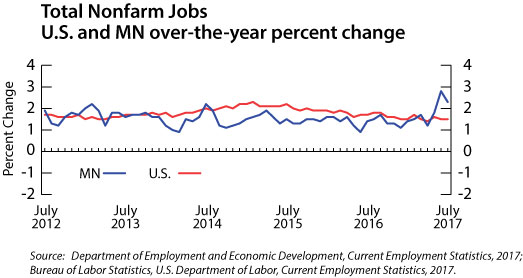by Nick Dobbins
August 2017
Monthly analysis is based on unadjusted employment data.
Employment in the Minneapolis-St. Paul MSA decreased by 10,989 (0.5 percent) in July. However, this estimate is not seasonally adjusted, and since the MSA has lost employment in every single July on record since 1968, this does not tell us much. The past two Julys have shown smaller than usual declines, which may suggest a recent change in seasonal patterns. July’s loss was driven by the shedding of 16,117 jobs (6.4 percent) from Government employment, specifically concentrated in Local Government Education, which dropped 16,825 jobs (17.7 percent) as schools headed to summer break. Mining, Logging, and Construction had the largest gains in the MSA for July, both proportionally and in total jobs, adding 2,063 or 2.4 percent. Annually the metro area added 53,063 jobs (2.7 percent), keeping it slightly ahead of the statewide over-the-year growth rate of 2.3 percent. Educational and Health Services continued to lead the way, adding 20,953 jobs (6.6 percent), which was the largest numerical and proportional growth of any supersector. The Financial Activities supersector lost employment on an annual basis, shedding 143 jobs (0.1 percent). It was the only supersector in the metro with negative annual growth, and this was its first month with over-the-year losses since December of 2014, having posted consistent growth of 1 percent or more for the previous two years. The decline was largely driven by the loss of 1,049 jobs (3.6 percent) in the Real Estate and Rental and Leasing component sector.
The Duluth-Superior MSA lost 1,020 jobs (0.7 percent) in July, matching the statewide over-the-month decline. Besides Government employers (off 2,076 or 7.9 percent, with 1,946 from Local Government) losses were also posted in Other Services (down 35 or 0.5 percent) and Information, which lost one single job (0.1 percent). The largest gains came in Mining, Logging, and Construction, up by 454 (4.3 percent). Annually Duluth added 3,206 jobs (2.4 percent). Once again Information was the only supersector in the area to lose jobs, off by 68 (4.7 percent). It was the fifth consecutive month of job losses in the supersector. The largest gains in Duluth came in Educational and Health Services (up 1,087 or 3.5 percent) and Mining, Logging, and Construction (up 1,046 or 10.6 percent). That’s down from the 15.6 percent annual growth in the supersector for June, and that number is likely to continue to shrink in the coming months as the turmoil that has wracked the industry and region in recent years continues to stabilize.
Employment in the Rochester MSA was down by 565 (0.5 percent) in Jul.y While the lion’s share of those losses came from Local Government employers, a number of supersectors had smaller monthly declines. Mining, Logging, and Construction lost 29 jobs (0.6 percent), and it was the only MSA in the state to show negative growth in that industry group. Professional and Business Services and Other Services also both lost employment, down by 24 (0.4 percent) and 10 (0.2 percent) respectively. Annually Rochester added 2,243 jobs (1.9 percent), lagging slightly behind the state’s overall growth for the second straight month. The over-the-year gains were built in large part on the addition of 1,269 jobs (2.6 percent) in Educational and Health Services, although Mining, Logging, and Construction (up 163 or 3.3 percent), Professional and Business Services (up 316, 5.6 percent), and Other Services (up 128, 3.2 percent) all showed larger proportional growth.
Employment in the St. Cloud MSA was down by 1,023 (0.9 percent) in July. Government employers shed 1,240 jobs (8.3 percent). Trade, Transportation, and Utilities lost 116 jobs (0.5 percent), and Other Services lost 26 (0.7 percent). The largest gains came in Mining, Logging, and Construction, which added 237 jobs (3 percent). Annually St. Cloud added 1,944 jobs (1.8 percent). Notable growth occurred in Mining, Logging, and Construction (up 850 or 11.6 percent) and Educational and Health Services (up 853 or 4.1 percent). The largest over-the-year losses came in the Financial Activities supersector, which lost 247 jobs or 4.7 percent.
The Mankato-North Mankato MSA lost 1,692 jobs (2.9 percent) in July. While losses are common this time of year, the proportional decline in Mankato was among the worst in the state. The losses were concentrated in Government employment, which was off by 1,809 jobs (18.2 percent). Every other published industry group showed monthly growth. Over the year the area added 908 jobs (1.7 percent). Private sector employers added 612 jobs (1.3 percent), and the public sector added 296 (3.8 percent).
The Fargo-Moorhead MSA lost 989 jobs (0.7 percent) in July. As was the case elsewhere in the state, the losses were largely caused by a drop of 2,353 jobs (12.8 percent) in Local Government employment. Annually the Fargo-Moorhead MSA added 3,004 jobs (2.2 percent). The largest gains came in Leisure and Hospitality, which added 953 jobs (6.9 percent).
The Grand Forks-East Grand Forks MSA lost 2,108 jobs (3.7 percent) in July. It represented the largest proportional over-the-month decline of any MSA in Minnesota although it came almost entirely from Local Government employment (down 1,827 or 28.4 percent). Annually the area lost 377 jobs (0.7 percent). It was the only MSA in Minnesota to lose jobs over the year. The decline came primarily from Mining, Logging, and Construction employment, which was off by 1,105 (22.6 percent).
